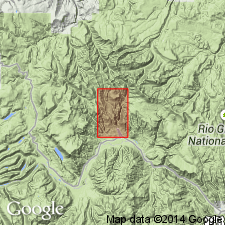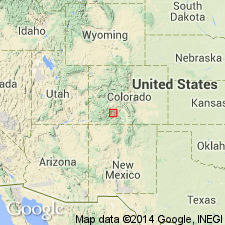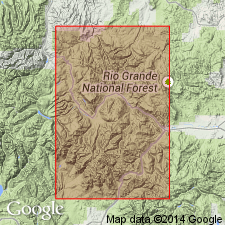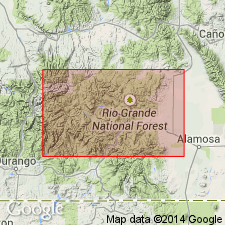
- Usage in publication:
-
- Phoenix Park quartz latite*
- Modifications:
-
- Original reference
- Dominant lithology:
-
- Quartz latite
- AAPG geologic province:
-
- San Juan Mountains province
Summary:
Phoenix Park quartz latite of Alboroto group of Potosi volcanic series. Lava flows and tuff breccias of a fairly uniform rock. Thickness 0 to 500 feet. Is a formation in Alboroto group of Potosi volcanic series. The main body rests on fairly regular surface of Campbell Mountain rhyolite, and unconformably underlies Mammoth Mountain rhyolite. Another body of similar rock occurs as a lens between flows of Campbell Mountain rhyolite, and it is believed there was an interbedding of the two types of material. Age is Miocene.
Named from development about Phoenix Park, [in sec. 5, T. 42 N., R. 1 E., and sec. 32, T. 43 N., R. 1 E., San Luis Peak 7.5-min quadrangle, Mineral Co.], Creede district, southwestern CO. [Additional locality information from USGS historical topographic map collection TopoView, accessed February 28, 2013.]
Source: US geologic names lexicon (USGS Bull. 896, p. 1650-1651).

- Usage in publication:
-
- Phoenix Park Member*
- Modifications:
-
- Revised
- AAPG geologic province:
-
- San Luis basin
Summary:
In San Luis basin, the Phoenix Park Quartz Latite of Emmons and Larsen (1923) is revised to Phoenix Park Member, younger member of La Garita Quartz Latite. Age is middle and late Tertiary. Formed after subsidence of the La Garita cauldron and before the Farmers Creek Rhyolite.
Source: GNU records (USGS DDS-6; Denver GNULEX).

- Usage in publication:
-
- Phoenix Park Member*
- Modifications:
-
- Revised
- AAPG geologic province:
-
- San Juan Mountains province
- San Luis basin
- Piceance basin
Summary:
Pg. A36-A37, A78. Phoenix Park Member of La Garita Tuff is reassigned to the Fish Canyon Tuff as its uppermost member. Consists of three small densely welded ash-flow tuffs that are interlayered with the younger Bachelor Mountain and Carpenter Ridge Tuffs. Is younger than La Garita Member of Fish Canyon Tuff and older than unnamed outflow member at base of Carpenter Ridge Tuff. Age is late Oligocene.
Source: Publication.

- Usage in publication:
-
- Phoenix Park Member*†
- Phoenix Park unit*
- Modifications:
-
- Abandoned
- AAPG geologic province:
-
- San Juan Mountains province
Summary:
In its type area, Creede district, Mineral County, Colorado (San Juan Mountain province), the †Phoenix Park Member of Fish Canyon Tuff is abandoned as a formal term. Renamed Phoenix Park unit (informal) and assigned to the Carpenter Ridge Tuff. Unit previously interpreted to be ash flows from La Garita caldera; believed to interfinger with and overlie Bachelor Mountain Member of Carpenter Ridge Tuff. Unit now interpreted as landslide breccias derived from northeast wall of Bachelor caldera (in La Garita Mountains) during subsidence of caldera. Is generally equivalent to the Outlet Tunnel and Shallow Creek units, both of Carpenter Ridge Tuff. Bachelor caldera was source of Carpenter Ridge Tuff. Age is Oligocene.
Source: Modified from GNU records (USGS DDS-6; Denver GNULEX).
For more information, please contact Nancy Stamm, Geologic Names Committee Secretary.
Asterisk (*) indicates published by U.S. Geological Survey authors.
"No current usage" (†) implies that a name has been abandoned or has fallen into disuse. Former usage and, if known, replacement name given in parentheses ( ).
Slash (/) indicates name conflicts with nomenclatural guidelines (CSN, 1933; ACSN, 1961, 1970; NACSN, 1983, 2005, 2021). May be explained within brackets ([ ]).

